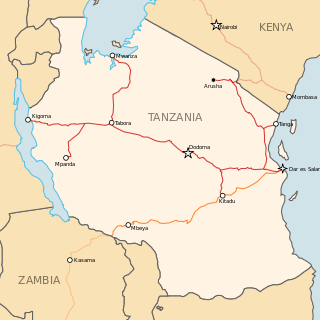
Tanzania, officially the United Republic of Tanzania, is a country in East Africa within the African Great Lakes region. It borders Uganda to the north; Kenya to the northeast; the Indian Ocean to the east; Mozambique and Malawi to the south; Zambia to the southwest; and Rwanda, Burundi, and the Democratic Republic of the Congo to the west. Mount Kilimanjaro, Africa's highest mountain, is in northeastern Tanzania. According to the 2022 national census, Tanzania has a population of nearly 62 million, making it the most populous country located entirely south of the equator.

Tanzania comprises many lakes, national parks, and Africa's highest point, Mount Kilimanjaro. Northeast Tanzania is mountainous, while the central area is part of a large plateau covered in grasslands. The country also contains the southern portion of Lake Victoria on its northern border with Uganda and Kenya.
Transport in Tanzania includes road, rail, air and maritime networks. The road network is 86,472 kilometres (53,731 mi) long, of which 12,786 kilometres (7,945 mi) is classified as trunk road and 21,105 kilometres (13,114 mi) as regional road. The rail network consists of 3,682 kilometres (2,288 mi) of track. Commuter rail service is in Dar es Salaam only. There are 28 airports, with Julius Nyerere International being the largest and the busiest. Ferries connect Mainland Tanzania with the islands of Zanzibar. Several other ferries are active on the countries' rivers and lakes.

The Catholic Church in Tanzania is part of the worldwide Catholic Church, under the spiritual leadership of the Pope in Rome.

The following outline is provided as an overview of and topical guide to Tanzania:

Railway stations in Tanzania include:

Tanzania Ports Authority (TPA) is a parastatal public corporation acting under the aegis of the Ministry of Infrastructure Development, that has the responsibility "to manage and operate" the ocean ports and lake ports of the country of Tanzania. The Tanzania Ports Authrorty headquarters are located in Mchafukoge ward of Ilala District in Dar es Salaam Region. It is a member of the Port Management Association of Eastern and Southern Africa.
Azania Bank Limited, whose formal name is First Adili Bancorp Limited, and is commonly referred to as Azania Bank, is a commercial bank in Tanzania. It is licensed by the Bank of Tanzania (BOT), the central bank and national banking regulator.
Exim Bank (Tanzania) (EBT), is a commercial bank in Tanzania, the second-largest economy in the East African Community. The bank is licensed by the Bank of Tanzania, which is the country's central bank and national banking regulator.

Akiba Commercial Bank (ACB) is a commercial bank in Tanzania. It is licensed by the Bank of Tanzania, the central bank and national banking regulator.
Commercial Bank of Africa (Tanzania)(CBAT) is a commercial bank in Tanzania. It is licensed by the Bank of Tanzania, the country's central bank and national banking regulator. The bank is a subsidiary of the Commercial Bank of Africa Group and has its headquarters in Nairobi, Kenya.

The People's Bank of Zanzibar (PBZ) is a commercial bank in Tanzania. It is licensed by the Bank of Tanzania, the central bank and national banking regulator.

TIB Development Bank, formerly known as Tanzania Investment Bank (TIB), is a government-owned development bank in Tanzania. The bank is the first development finance institution established by the Government of Tanzania. The activities of TIB are supervised by the Bank of Tanzania, the central bank and national banking regulator. TIB is registered as a Registered Financial Institution.

Absa Bank Tanzania Limited (ABT), formerly Barclays Bank Tanzania Limited, is a commercial bank in Tanzania and a subsidiary of South Africa-based Absa Group Limited. ABT is licensed by the Bank of Tanzania, the country's central bank and national banking regulator.

Medical Stores Department (MSD) was established by the Act of Parliament No.13 of 1993 as an autonomous department under the Ministry of Health, Social Development, Gender, Elderly and Children responsible for develop, maintain and manage an efficient and cost effective system of procurement, storage and distribution of approved medicines and medical supplies required for use by the public health services as the Ministry of Health, Social Development, Gender, Elderly and Children may from time to time approve.
Nane Nane Day on 8 August celebrates to recognize the important contribution of farmers to the national Tanzanian economy. Nane Nane means "eight eight" in Swahili, the national language of Tanzania.

Smile Communication Tanzania Ltd is a telecommunications network company in Tanzania. It was registered in July 2009 and began commercial operations in May 2013. The company is a subsidiary of Smile Telecoms Holdings, a South African telecommunications conglomerate, whose subsidiaries include: (a) Smile Telecom (Nigeria) (b) Smile Telecom (Tanzania) (c) Smile Telecom and (d) Smile Telecom (Uganda). Smile's first country of operation in Africa was in Tanzania. Smile Tanzania was the first company to launch commercial 4G LTE services in Tanzania and began its operations in the city of Dar es Salaam.
The Tanzanian Championship is the second tier of league football in Tanzania. The league is made up of sixteen teams that play thirty rounds, home and away.The league was formed in 1930.














